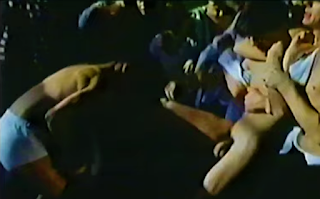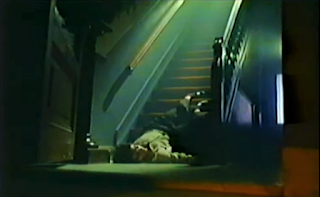on the periphery
by Douglas Messerli
Marcel Achard, Max Ophūls, and Wademant (screemplay, based
on the novel Madame de by Louise de
Vilmorin), Max Ophūls (director) Madame
de… (The Earrings of Madame de…)
/ 1953
The Comtesse Louise de… is represented in the
first moments of Max Ophūls' Madame de… (The Earrings of Madame de…) by only her
hand and arm—a fragmented and disembodied being—at home with the objects which
she is apparently reviewing, the boxes of jewels and her closets of elaborate
gowns and furs. We soon discover that she is choosing from among these precious
objects something to sell—and as her entire body slowly comes into perspective,
we comprehend that she is attempting to raise money to pay outstanding debts.
She is, so Ophūls tells us, a pampered and
frivolous woman, who might have continued her life in such isolated luxury had
she not selected to sell a pair of diamond earrings, given to her by her
husband. Among her cherished gems and clothes, the earrings are, apparently,
her least favorite thing—also an indication, perhaps, of her position regarding
her husband. Apparently, she has had neither the courage nor the trust to tell
him of her financial situation, even though it soon becomes clear that he would
have quickly resolved the problem and overlooked her financial indiscretions.

Once we have glimpsed Louise we see the
beautiful woman so attached to these things. Indeed, throughout the film, Ophūls
shows off Danielle Darrieux’s beauty through her exquisite gowns and jewels in
the manner almost reminiscent of today’s “fashion” films such as the recently
issued The Duchess (2008). Ophūls has
been neglected, in part, precisely because of the elegance of his films;
particularly in the 1950s atmosphere of abstract expressionism and discordant
12-tone music, Ophūls’ highly narratively framed histories of sexual
indiscretion and innuendo seemed old-fashioned and out of place. Even in his
otherwise positive review of this film, Roger Ebert summarizes one standard
view of Ophūls’ world: The Earrings of
Madame de… “…is one of the most
mannered and contrived love movies ever filmed.” As the reader of my essays on
film will recall, I am a great admirer of theatrical filmmaking. But I would
argue that, except for the Macguffin, the reappearing earrings, the love
story Ophūls tells, in terms of the great romances of fiction, is not nearly so
contrived and mannered as it may seem.
One must also recall, of course, that any
focus on women in 1953 might have been seen, in the testosterone-smoke-filled
rooms of journalism, as simply uninteresting. Critic Molly Haskell summarizes
that position best in Richard Roud’s comments: “What are Ophūls' subjects? The
simplest answer is: women. More specifically, women in love. Most often, women
who are unhappily in love, or to whom love brings misfortune of one kind or
another.”
Obviously things have changed some since
those evaluations, and Ophūls' work, and, thanks to intelligent analyses by
critics such as Andrew Sarris, his wife, Molly Haskell, and Pauline Kael, The Earrings of Madame de… is now
recognized as a masterwork, even though, as Haskell notes, it “never seems to
attain the universal accolade of ‘greatness,’ automatically granted to movies
like The Godfather or Citizen Kane.”
Ophūls clearly loved Louise de
Vilmorin’s 1951 novel because of the
recurring theme of the earrings. It provided him with a structure against which
the “real” story, the love between Madame de… and Baron Fabrizio Donati
(handsomely played by film director Vittorio De Sica), develops. But in order
to even comprehend this structural device, we need to attend not only to the
seemingly isolated and pampered world of Louise, but the society of the male
characters, represented in an almost dichotomous manner by Louise’s husband,
Général André de… (Charles Boyer), a military figure who seems to have stepped
right out of a book by Ophūls’ favorite writer Arthur Schnitzler, and the
romantically-inclined ambassador Baron.

Proud, loyal, and outwardly loving
of his wife, André is, nonetheless, a man of action. Although he appears to
easily forgive his wife’s indiscretions, he can do so only because he believes
all women inferior to rational beings. They are to be petted and forgiven,
never openly chastised. Like Louise’s jewelry and furs, they are not worthy of
the passion of anger; they are, rather, possessions,
like a military decoration one wears on one’s lapel. It is strange that,
although most critics make a great fuss about Louise’s relationship (apparently
a love affair that is never sexually consummated) with the Baron, they speak
little of André’s mistress, Lola (described in de Vilmorin’s original book
simply as “a Spanish lady”). In the French society of the day (perhaps still
today) men are expected to have mistresses, but women are to be shamed by
behaving similarly.
If Louise is insensitive about her
husband’s expensive gift of the earrings, so too is he to his wife—once he has
repurchased them from the jeweler to whom Louise has sold them—by presenting
them as a parting present to his mistress. Ophūls’ revealing scene of Louise’s
and the Général’s living arrangements, each bedded in adjoining rooms into
which they shout their bed-time messages, demonstrates that, although André may
be a man of valor, he is most definitely not a man of passion. As we discover
later in the film, he does not even believe in emotions: “Unhappiness,” he
declares, “is an invented thing.”
Is it any wonder then that all of Louise’s
friends, the society world into which she is cocooned, wish her a better
companion: the Baron Fabrizio Donati, a man whose life is devoted to social
skills. Ophūls literally whirls the couple into a relationship as he employs
Strauss’s dizzying waltzes as the modus
operandi of their romance. Warned never to hope—the Madame is known for
leaving all of her hopeful suitors in the lurch—the Baron insinuates himself
into Louise’s world less as a male intruder than as an expert thief of the
heart.
How different is Louise’s reaction to his
gift of the same diamond earrings compared with the gift from her husband. Now,
it appears, the earrings—which he has purchased in Constantinople, where Lola
has given them up to pay a gambling debt—are among Louise’s most cherished
things; she sees them with different eyes.
Pretending to rediscover them in the
confines of one of her gloves, Louise proudly wears the earrings to a ball,
only to have them snatched away again, this time by her husband, who recognizes
in his wife’s sudden admiration of them, how deeply she has fallen for the
Baron. His insistence that she give them up to her baby-bearing niece helps us
to realize just how out-of-touch the Madame is with everyday life. Tormented in
the loss of her jewels, Louise bends briefly to coddle the new baby as she
breaks into tears. But the tears, quite clearly, have nothing to do with the
child, but with the loss of her baubles. For Louise is herself still a child,
and will never be able to share the fulfillment of motherhood and adult love.
The Baron may be an expert romancer, but
he is, after all, still a diplomat, and with Louise’s various indiscretions—her
white lies to him, her husband, and even to herself—he has little choice but to
break off their relationship. Suddenly the object of so much love and attention
is utterly abandoned, without even an escape from the life she was destined to
live out. In the beginning of the film Louise declares that she wishes her
mother were still living to help her in her decisions. Now she is left only
with La Nourrice, her loving and protective nursemaid who would draw her into a
darker and even more isolated world of tarot and magic. The violence and anger,
lurking just below the surface of André’s seemingly calm demeanor, explode as he
challenges the Baron to a duel—a duel which says nothing of his wife, but is
superficially based on the Baron’s opposition to the military.
Against love and diplomacy violence often
wins out. Louise, attempting to halt the duel, remains on the periphery of the action—outside
of history and event—as she has been all her life, unable to catch her breath. For
one of the first times in her existence, her fainting spell is real, as she
suffers what most of Ophuls’ heroines ultimately suffer, a heart-attack, a
breaking of the heart!
Los Angeles, September 24, 2008
Reprinted
from Nth Position [England] (October
2008).
Reprinted from Reading
Films: My International Cinema (2012).


.jpg)
.jpg)
.jpg)
.jpg)
















